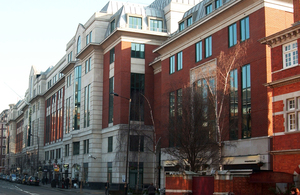Ministers cut traffic signs red tape for local councils
Measures to reduce time-consuming and costly bureaucracy for councils wanting to use 20 miles per hour schemes were announced today.

Measures to reduce time-consuming and costly bureaucracy for councils wanting to use 20 miles per hour (mph) schemes were announced today (9 June 2011) by Regional and Local Transport Minister Norman Baker.
Today’s changes - the first to be announced as part of the traffic signs policy review - will mean that councils can use signs painted on roads as an alternative to expensive upright signs, cutting street clutter as well as costs.
In addition, the government will reduce the need for councils to use speed humps in 20 mph zones and make it cheaper and easier for councils to put in place variable speed limits outside schools when local residents want these schemes.
Norman Baker said:
I want to end the era of top-down government by providing a radical devolution of power to local authorities and communities.
If councils and local communities want to put in place 20 mph schemes on residential roads or use common-sense measures such as variable speed limits outside schools, then they should be able to do so without spending time and money satisfying unnecessary Whitehall diktats.
These changes will reduce costs for councils wanting to use 20 mph schemes, allowing them to act faster in response to the needs of their local residents while still ensuring that drivers know what speed they should drive at.
The changes include:
- expanding the list of specified traffic calming measures allowable in 20 mph zones to include repeater signs and mini-roundabouts - this would allow zones to be introduced with fewer road humps or chicanes where appropriate
- allowing local authorities to use speed limit symbols painted on roads more often as repeater signs in 20 mph zones and limits - upright signs will still be required to indicate the start and end of 20 mph schemes
- allowing local authorities to place signs at the entry and exit of variable speed limits - e.g. outside schools - on only one side of the road rather than on both sides of the road as is currently the case
- allowing the use of either flashing warning lights or specified flashing lights with a static sign at the entry to variable speed limits which are cheaper for councils to buy
- allowing the use of a sign design for advisory 20 mph limits using flashing school warning lights
- councils will now be able to request council-wide authorisations for these measures to be used in 20 mph schemes on residential roads where cost-benefit analysis has shown that such schemes would be worthwhile - this will mean that councils can apply these measures without getting approval from government in each case
It remains the decision of local councils to decide whether or not to use 20 mph schemes following robust cost-benefit analysis of any such proposals.
The traffic signs policy review is due to publish its final report later this summer.
In addition, the Department for Transport plans to revise the guidance on speed limits with the aim of increasing flexibility for local authorities. The department will provide an economic tool to help them to assess the full costs and benefits of any proposed schemes so that they can use measures which are both appropriate and good value for money.
News desk enquiries
Media enquiries 0300 7777 878
Switchboard 0300 330 3000
Background information
Local authorities are able to use their power to introduce 20 mph speed schemes in (a) major streets where business on foot is more important than slowing down road traffic and (b) lesser residential roads in cities, towns and villages, particularly where this would be reasonable for the road environment, there is community support and streets are being used by pedestrians and cyclists. Evidence suggests that in residential streets, and in town centres where there is likely to be a conflict between vehicles and pedestrians, carefully implemented 20 mph zones can contribute to an improvement in road safety.
The strategic road safety framework, published on 11 May 2011, announced plans to revise and reissue the DfT guidance on speed limits in urban areas with the aim of increasing flexibility for local authorities
It also indicated that DfT will provide a toolkit to help local authorities assess the full costs and benefits of proposed schemes. This should help them make robustly defensible decisions about speed limits.